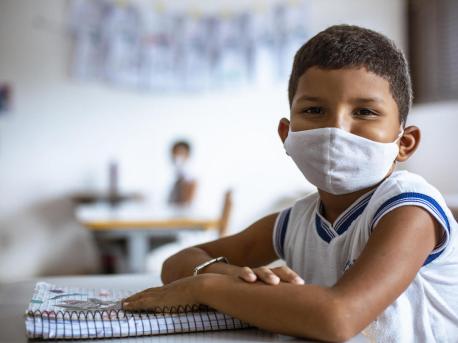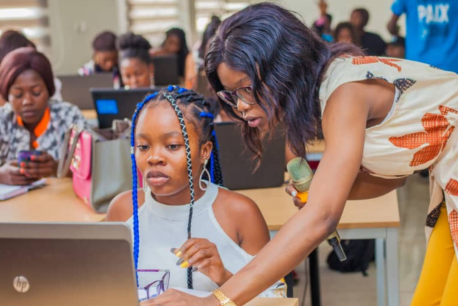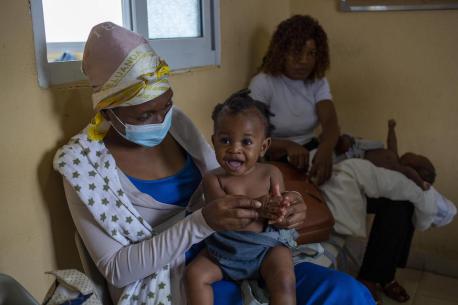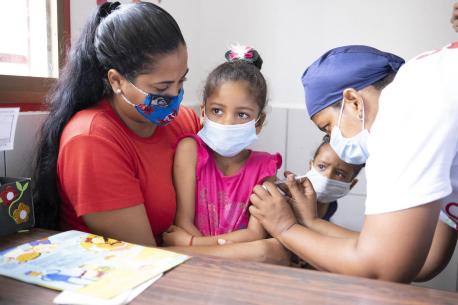
Back to School in a Pandemic
As children and teachers around the world head back to the classroom, UNICEF is working with UNESCO, the World Food Program and ministries of education to ensure schools are operating safely so students can resume in-person learning.
There is much more to be done: According to the latest data from UNESCO, more than 870 million students at all levels are currently facing some disruptions to their education. Globally, around 131 million schoolchildren in 11 countries missed three-quarters of their in-person instruction time from March 2020 to September 2021 due to the COVID-19 pandemic.
Bangladesh

© UNICEF/UN0521682/Mawa
Children wash their hands before entering the classroom at Kalamarchara Government Primary School in Cox's Bazar, Bangladesh. The country had one of the longest COVID-19 school closures in the world: an estimated 8 million learners in Bangladesh have been out of school since March 2020.
Indonesia

© UNICEF/UN0520817/Wilander
Aurora, 5, attends class at Angkasa 1 Kindergarten in East Jakarta, Indonesia. September was Aurora’s first month back at school after almost a year and a half of learning from home. “I’m happy to be back in school,” said Aurora from behind her mask and face shield. “I’m happy to meet my friends again.”
All 530,000 schools in Indonesia closed in March 2020, affecting more than 60 million students and 4 million teachers. Since then, just 39 percent of schools have reopened for limited face-to-face learning. UNICEF is working with the Indonesian government to support remote learning and facilitate the safe return to classrooms.
Côte d'Ivoire

© UNICEF/UN0523202/Diarassouba
The first day of school is a landmark moment in a child's life. Children are excited to start the school year in Yopougon, a suburb of Abidjan, southern Côte d'Ivoire.
Haiti

© UNICEF/UN0519248/Ergen
More than 700 schools were damaged and destroyed by the earthquake that hit Haiti on Aug. 14, 2021, just weeks before the start of the new school year. UNICEF and partner IDEJEN are working in Les Cayes and surrounding areas to help children resume their regular routines and continue learning.
Haiti

© UNICEF/UN0516376/Haro
UNICEF and partners have established temporary classrooms in Haiti where students can continue their educations while schools are being repaired. "Putting children back in classrooms is perhaps the best way to make sure they — and their families and communities — can recover" from the trauma of the earthquake, said UNICEF Representative in Haiti Bruno Maes.
Brazil

© UNICEF/UN0500156/Pastorelli
Ten-year-olds Maria Eduarda, Jaqueline and Estela are happy to see their teachers face-to-face again at Brigadeiro Gavião Peixoto State School, in São Paulo, Brazil. Students start the day with temperature checks, then wash their hands and head to class, where desks are positioned 5 ft. apart.
At least 47 million students have resumed in-person learning in Latin American and the Caribbean; another 86 million children in the region remain out of the classroom. “Digital education should continue and improve, but it’s clear that during the pandemic the most marginalized families haven’t had access to learning," said Jean Gough, UNICEF Regional Director for Latin America and the Caribbean. "Every day out of the classroom brings the most vulnerable children closer to dropout, gang violence, abuse or human trafficking."
United Nations headquarters

© UNICEF/UN0522071/Gary He/UNICEF via Getty Images
An installation outside UN headquarters in New York dramatizes the estimated 1.8 trillion hours — and counting — of in-person instruction children have missed since the onset of the COVID-19 pandemic and during subsequent lockdowns. The clock displays in real time the growing cumulative total number of learning hours children continue to lose.
“As classes resume in many countries around the world, millions of students are heading into a third academic year without stepping foot in a classroom,” said UNICEF Executive Director Henrietta Fore. “The losses that students are incurring from not being in school may never be recovered.”
UNICEF is working with partners around the world to ensure that every child receives a quality education. You can help.
Top photo: Students are happy to be back in the classroom in Serrinha, in the northeastern state of Rio Grande do Norte, Brazil. The country's schools closed in March 2020 to prevent the spread of COVID-19, and began to reopen in February 2021. UNICEF has been working with national, state and municipal governments to ensure a safe reopening of schools through protocols, donations and advocacy. © UNICEF/UN0499532/Potter
HOW TO HELP
There are many ways to make a difference
War, famine, poverty, natural disasters — threats to the world's children keep coming. But UNICEF won't stop working to keep children healthy and safe.
UNICEF works in over 190 countries and territories — more places than any other children's organization. UNICEF has the world's largest humanitarian warehouse and, when disaster strikes, can get supplies almost anywhere within 72 hours. Constantly innovating, always advocating for a better world for children, UNICEF works to ensure that every child can grow up healthy, educated, protected and respected.
Would you like to help give all children the opportunity to reach their full potential? There are many ways to get involved.





